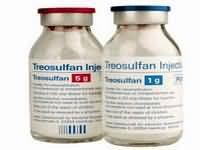CLINICAL USE
Alkylating agent for ovarian cancer
DOSE IN NORMAL RENAL FUNCTION
IV: 3–8 g/m 2 every 1–3 weeks; doses >3 g/ m2 should be given as an infusion Doses up to 1.5 g/m 2 have been given IP Oral: 1 g daily in 4 divided doses for 2–4 weeks or 1.5 g daily in 3 divided doses for 1 week Or according to local protocol
PHARMACOKINETICS
DOSE IN RENAL IMPAIRMENT
GFR (mL/MIN)
DOSE IN PATIENTS UNDERGOING RENAL REPLACEMENT THERAPIES
IMPORTANT DRUG INTERACTIONS
Potentially hazardous interactions with other drugs
ADMINISTRATION
Reconstition
20 or 100 mL water for injection for 1 g and 5 g vials respectively
Route
Oral, IV, IP
Rate of Administration
3 g/m 2 over 5–10 minutes (8 g/m2 over 30 minutes)
Comments
Powder reconstitutes easier if water heated to 25–30°C
OTHER INFORMATION
Treosulfan is a prodrug of a bifunctional alkylating agent; high and relatively constant bioavailability. Mean urinary excretion of the parent compound is ~15% over 24 hrs Haemorrhagic cystitis has occurred after intravesical or intravenous administration .
